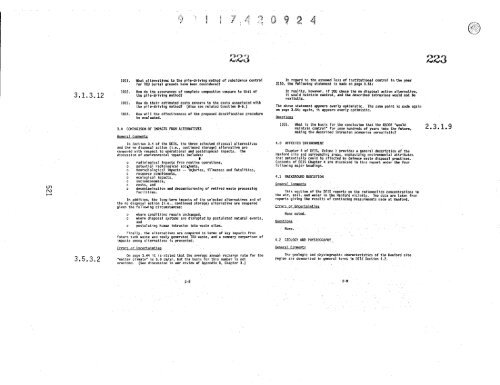EIS-0113_Section_11 - Hanford Site
EIS-0113_Section_11 - Hanford Site
EIS-0113_Section_11 - Hanford Site
Create successful ePaper yourself
Turn your PDF publications into a flip-book with our unique Google optimized e-Paper software.
VJ<br />
223 223<br />
10<strong>11</strong>. What alternatives t0 the pile-driving method of subsidence control<br />
for TRU burial grounds have been considered?<br />
1012. How do the assurances of complete compaction compare to that of<br />
3,1, 3.12 the pile-driving method?<br />
1013. How d0 their estimated costs compare to the costs associated with<br />
the pile-driving method? (Also see related Question B-6.)<br />
1014. Now will the effectiveness of the proposed densification procedure<br />
be evaluated.<br />
3.4 COMPARISON Or IMPACTS FROM ALTERNATIVES<br />
General comments<br />
In regard to the assumed loss of institutional control in the year<br />
2150, the following statement is made on page 3.51:<br />
In reality, however, if WE chase the no disposal action alternative,<br />
it would maintain control, and the described intrusions would not be<br />
realistic.<br />
The above statement appears overly optimistic. The same point is made again<br />
on page 3.64; again, it appears overly optimistic.<br />
Questions<br />
1015. What is the basis for the conclusion that the USDOE "would<br />
maintain control' for some hundreds of years into the future,<br />
making the described intrusion scenarios unrealistic?<br />
2.3.1.9<br />
ill<br />
N<br />
r.<br />
3.5.3.2<br />
In <strong>Section</strong> 3.4 of the D<strong>EIS</strong>, the three selected disposal alternatives<br />
and the no disposal action (i.e., continued storage) alternative are<br />
compared with respect to operational and postdispos at impacts. The<br />
discussion of environmental impacts includes:<br />
1<br />
• radiological impacts from routine operations,<br />
• potential radiological acciients,<br />
• nonradiological impacts -- injuries, illnesses and fatalities,<br />
• resource commitments,<br />
• ecological impacts,<br />
socioeconomics,<br />
o.' costs, and<br />
o decontamination and decommissioning of retired waste processing<br />
facilities.<br />
In addition, the long-Leon impacts of the selected alternatives and of<br />
the no disposal action (i.e., continued storage) alternative are compared<br />
given the following circumstances:<br />
• where conditions remain unchanged,<br />
• where disposal systems are disrupted by postulated natural events,<br />
and<br />
• postulating human intrusion into waste sites.<br />
Finally. the alternatives are compared in terms of key impacts from<br />
future tank waste and newly generated TRU waste, and a summary comparison of<br />
impacts among alternatives is presented.<br />
Errors or Uncertainties<br />
On page 3.44 it in stated that the average annual recharge rate for the<br />
"wetter climate" is 5.0 cMyr, but the basis for this number is not<br />
provided. (See discussion in our review of Appendix 0, Chapter 3.)<br />
4.0 AFFECTED ENVIRONMENT<br />
Chapter 4 of D<strong>EIS</strong>, Volume I provides a general description of the<br />
<strong>Hanford</strong> site andsurrounding areas., emphasizing environmental attributes<br />
that potentially could be affected by defense waste disposal practices.<br />
Contents of D<strong>EIS</strong> Chapter 4 are discussed in this report under the four<br />
following major headings.<br />
4.1 BACKGROUND RADIATION<br />
Lenerai Commenti<br />
This section of the D<strong>EIS</strong> reports on the radionuclide concentrations in<br />
the air, soil, and water in the <strong>Hanford</strong> vicinity. Tine data are takenfrom<br />
reports giving the results of continuing measurements made at <strong>Hanford</strong>.<br />
rr rs or Oedertafnti es<br />
Q-ggigns<br />
None noted.<br />
None.<br />
4.2 GEOLOGY AND PHYSIOGRAPHY<br />
General Comments<br />
The geologic and physiographic characteristics Of the <strong>Hanford</strong> site<br />
region are suemmrized in general terms in D<strong>EIS</strong> section 4.2.<br />
2-8 29

















